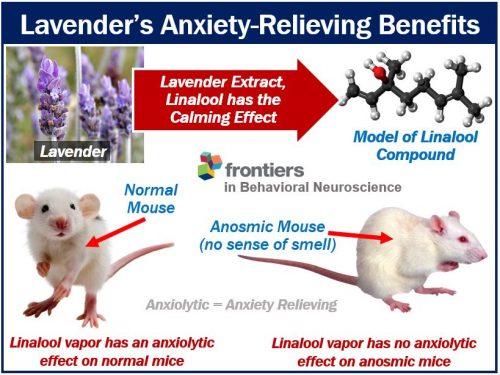The smell of lavender really is relaxing, a new study confirms. Its effects rely on our sense of smell rather than absorption into the bloodstream. Japanese scientists say that linalool, lavender’s active compound, may have anxiety treatment potential.
Researchers from Kagoshima University wrote about their study and findings in Frontiers in Behavioral Neuroscience (citation below).
For thousands of years, lavender has worked its relaxing magic all around us. We plant it in our gardens and add it to our bath bombs. We also add lavender to many fabric softeners.
So, why don’t we use it extensively in our clinics and hospitals, and what is the science behind its relaxing effects?
Lavender – you have to smell it
In this latest study, researchers showed for the first time that we have to smell linalool to benefit from its calming effects. It is not a question of absorbing it into the lungs and subsequently into the bloodstream.
The authors believe we could use linalool to relieve anxiety disorders and relive preoperative stress.
Co-author Dr. Hideki Kashiwadani, from the Department of Physiology at Kagoshima’s Graduate School of Medical and Dental Sciences, said:
“In folk medicine, it has long been believed that odorous compounds derived from plant extracts can relieve anxiety.”
The other co-authors of the article were Hiroki Harada, Yuichi Kanmura, and Tomoyuki Kuwaki, all from Kagoshima University.

Regarding the effects of lavender extract linalool on mice, the authors wrote: “Classical anxiety-related behavioral tests showed that exposure to linalool odor induced significant anxiolytic effects. The effects were not observed in anosmic mice, indicating that the effects were triggered by olfactory input evoked by linalool odor.”
Anxiolytic drugs – safer alternatives
In medicine, we have long been looking for safer alternatives to current anxiolytic drugs like benzodiazepines. Anxiolytic means anxiety-relieving. However, scientists have rarely investigated these scented settlers for use in hospitals and clinics.
Several studies have confirmed linalool’s potent relaxing effect. Linalool (C10H18O) is a fragrant alcohol that we can find in lavender extracts.
Dr. Kashiwadani pointed out:
“However, the sites of action of linalool were usually not addressed in these studies.”
Lavender effects not through bloodstream
Many scientists had assumed that we had to adsorb lavender extracts to benefit from their calming effects. After getting into our bloodstream, scientists believed they would subsequently have a direct effect on the brain’s GABAARs.
GABAARs stands for Gamma-Aminobutyric Acid Type A Receptors – they are brain receptors. Benzodiazepines target GABAARs.
If linalool is to have clinical use in humans, we must first establish the mechanism of its relaxing effects.
Dr. Kashiwadani and colleagues carried out experiments on mice to determine whether it was the smell. In other words, they wanted to find out whether it was the odor of the lavender extract that triggered relaxation.
The human nose has olfactory (odor-sensitive) neurons. Was it stimulation of the olfactory neurons that had the calming effect? That is what the researchers wanted to find out.
Lavender – effect on mice
Dr. Kashiwadani said:
“We observed the behavior of mice exposed to linalool vapor, to determine its anxiolytic effects. As in previous studies, we found that linalool odor has an anxiolytic effect on normal mice. Notably, this did not impair their movement.”
The effects of benzodiazepines and linalool injections, on the other hand, are similar to those of alcohol.
When they exposed anosmic mice to linalool vapor, there was no anxiolytic effect. Anosmic mice have had their olfactory neurons destroyed – in other words; they have no sense of smell.
This suggested that olfactory signals evoked by linalool odor had a relaxing effect on the ‘normal’ mice In this context, ‘normal’ refers to the mice that had a sense of smell.
The researchers then treated some ‘normal’ mice with flumazenil. Flumazenil blocks benzodiazepine-responsive GABAA receptors. They then exposed these mice to the lavender extract linalool and found that the anxiolytic effect disappeared.
How does linalool activate GABAA receptors?
Dr. Kashiwadani said:
“When combined, these results suggest that linalool does not act directly on GABAA receptors like benzodiazepines do – but must activate them via olfactory neurons in the nose in order to produce its relaxing effects.”
“Our study also opens the possibility that relaxation seen in mice fed or injected with linalool could, in fact, be due to the smell of the compound emitted in their exhaled breath.”
Further studies are required, the researchers say. Specifically, studies to establish the safety, efficacy, and targets of linalool administered by different routes. Researchers need to carry out these studies before moving to human trials.
Dr. Kashiwadani said:
“These findings nonetheless bring us closer to clinical use of linalool to relieve anxiety – in surgery for example, where pretreatment with anxiolytics can alleviate preoperative stress and thus help to place patients under general anesthesia more smoothly.”
“Vaporized linalool could also provide a safe alternative for patients who have difficulties with oral or suppository administration of anxiolytics, such as infants or confused elders.”
Citation
“Linalool Odor-Induced Anxiolytic Effects in Mice,” Hiroki Harada, Hideki Kashiwadani, Yuichi Kanmura, and Tomoyuki Kuwaki. Frontiers in Behavioral Neuroscience, 23 October 2018 | https://doi.org/10.3389/fnbeh.2018.00241.
